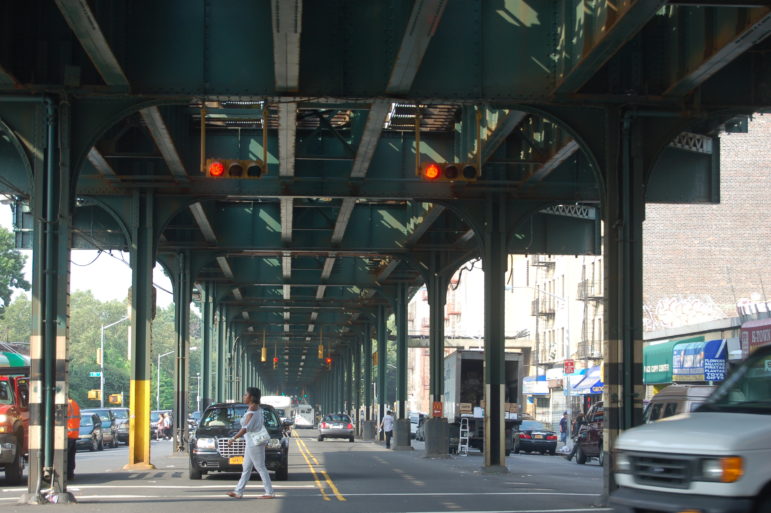
Daniel C
Under the 4 train along Jerome Avenue.
On Tuesday, the City Council Subcommittee on Zoning and Franchises, followed by the Council’s Land Use Committee, each voted unanimously to approve the Jerome Avenue rezoning in the western Bronx along with a package of city investments secured by Councilmembers Vanessa Gibson and Fernando Cabrera.
Gibson’s office says the full Council will likely vote on the rezoning on March 21st at 1:30 pm. Check here for updates.
The rezoning allows increased commercial and residential development along a corridor of the Bronx currently mostly zoned for auto-uses. It would become the fourth neighborhood rezoning that institutes a mandatory inclusionary zoning district, in which a portion of the housing is required to be income-targeted, to be signed into law by the de Blasio administration. East New York passed in 2016, and Far Rockaway and East Harlem last year.
The roughly three years of discussions leading up to this week’s vote have been contentious, with members of the Bronx Coalition for a Community Vision, an alliance of residents, tenant and community organizations, unions and others, expressing concerns that the rezoning would spur the market and cause the displacement of Jerome Avenue’s auto-businesses and the area’s low-income residents.
Others, particularly some community board members who voted in favor of the rezoning with conditions, have argued that the development plan must come with significant investments in the long-neglected neighborhood, especially new schools to relieve existing overcrowding and accommodate new families.
Notably, Gibson and Cabrera were successful in pushing the School Construction Authority for two new schools, each with 458 seats. One will be located at 2355 Morris Avenue, a city-controlled site in District 10, while another will be located in District 9; the location is still being determined.
Gibson also announced the preservation of 2,500 units of existing affordable housing over the next two years (up from the administration’s November commitment of 1,500 units), a $1.5 million fund to help auto-businesses relocate, the hiring of a workforce network coordinator, investments in parks, and more. The councilmembers are also launching two task forces, one on public health and another on “local hiring and responsible contracting.”
See below for a document including all the investments. In the document, the city commits to building affordable housing and senior housing on three city-owned sites, and names three other public sites where the city is also exploring affordable housing development. Perhaps responding to advocate’s calls for a “no net loss policy” to preserve existing regulated units, the city also commits to piloting a new “Partners in Preservation” initiative that will entail analyzing the regulated housing stock and creating preservation goals and strategies to preserve those units.
As for exactly how much affordable housing the rezoning will mandate on every development site under the mandatory inclusionary housing policy, the committee chose option 1 and the “deep affordability” option, the best of those available for lower-income families. No noteworthy modifications were made to the rezoning itself, despite some calls for a reduction in new residential density and increased retention of the auto-zoning.
Gibson praised the outcome of the negotiations, calling the final proposal a “comprehensive community development” plan that “represents the best interests of the Bronx residents who have always lived in our district through the dark days.” Similarly, Cabrera called it a “major victory after several years of community planning,” noting that he had originally requested that the city extend its rezoning geography from Gibson’s district up into his own and into Community Board 5.
“Although we did not achieve everything because no plan is perfect, my commitment remains…there is a lot more work that remains to be done,” Gibson added.
While Councilmember Francisco Moya, the new chair of the subcommittee on zoning as of January, voted in favor of the proposal, he took a surprisingly critical tone in his opening remarks, calling the city’s approach “frustrating and disheartening.”
“While progress has been made, a number of these issues still remain unresolved. The construction workforce piece of this rezoning has been inadequately addressed,” he said, expressing concerns about the safety and wages of construction workers. “How will we guarantee residents from the affected zipcodes access these jobs and in turn a pathway to the middle class? Similarly, I still feel that there are gaps in ensuring long-term affordability, that these residents stay in their homes. The proposal put forth in this plan represents nothing new for the Jerome Avenue residents, nor even in the city … We must take more comprehensive approaches to mass rezonings, and we need to plan, not just rezone.”
Meanwhile, the de Blasio administration commended the plan, noting that given the area’s weak market it expects that housing built in the “foreseeable future” will be completely affordable and subsidized. According to a statement from the administration, the city is committing about $189 million to the rezoning area, not including housing subsidies and the funds for the un-sited school.
“The Jerome Avenue Neighborhood Plan invests in communities that have never before gotten a fair shake,” said Melissa Grace, a spokesperson for City Hall, in a statement. “We’ll make major investments in protecting and building affordable housing, fixing streets, building new schools and improving parks. And we’ll invest in jobs, training and businesses along the corridor, including in the auto industry. We congratulate Council Members Gibson and Cabrera for their work crafting this important plan and fighting for their communities.”
The Bronx Coalition was planning a rally on Wednesday to call on the Council to vote against the rezoning, but it appears to be postponed due to the weather.









3 thoughts on “Jerome Avenue Rezoning Approved by Land Use Committee”
Pingback: BREAKING NEWS: Jerome Avenue Rezoning Passes Land Use, Full Council Next - This Is The Bronx
Pingback: Jerome Avenue Rezoning Moves A Step Closer to Reality as Land Use Committee Gives Unanimous Approval - Welcome2TheBronx™
Investments = nyc taxpayer dollars.